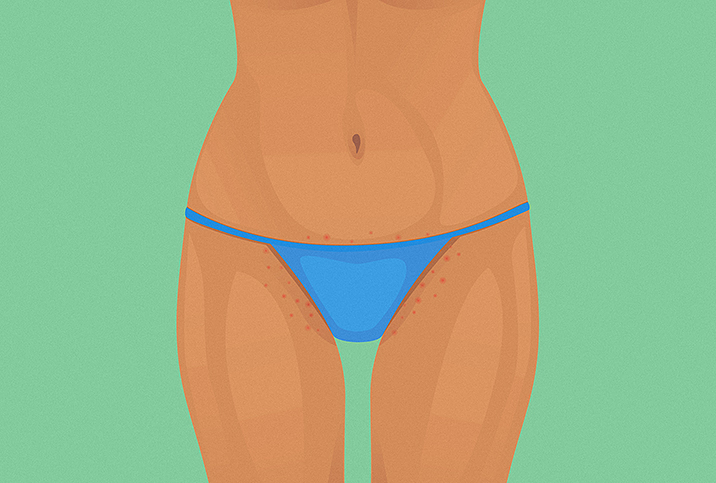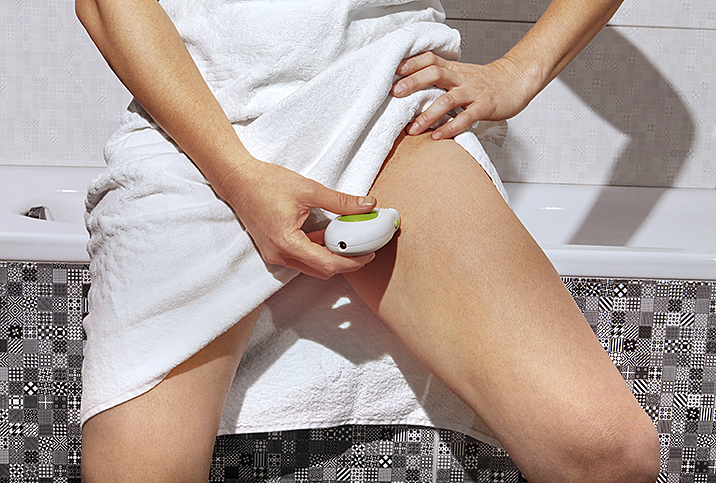How To Actually Prevent Ingrown Hairs Down There

If you've shaved, waxed, plucked or removed pubic hair by laser hair removal or electrolysis, you're probably familiar with ingrown hairs that pop up around your bikini line in the days after, often leaving painful or itchy cyst-like bumps, pus-filled pustules or darker areas of skin surrounding the hair follicle. While ingrown pubic hairs are more of a minor nuisance than an indication of serious health concerns, prevention might help you feel more comfortable and confident in your skin.
What is an ingrown hair?
When you remove pubic hair and it grows back, there's a chance it can grow toward and eventually into the skin, rather than up and out. This is an ingrown hair, especially common for people with thick, coarse or curly hair since these hair types are more prone to bending inward. This makes them common in the bikini or genital area, as pubic hair generally has a coarse, curly texture.
Removing hair (particularly through shaving) can give it a blunt edge that makes it easier to grow in the wrong direction. As the hair grows underneath the skin, the body reacts with an inflammatory response, which could bring pain, itching, redness, swelling or hyperpigmentation at the site of the ingrown hair. It might look similar to acne or resemble a cyst, boil, sore or group of angry-looking bumps called pseudofolliculitis.
Along with hair removal, ingrown hairs on the bikini line can happen as a result of chafing from tight-fitting pants and/or underwear or from friction during a workout, especially if you're not wearing moisture-wicking workout pants or underwear, and heat and sweat is being trapped in the pubic area.
If left untreated, ingrown hairs can get infected and require medical attention, such as an antibiotic or steroid ointment or wash. More commonly, they'll typically feel irritated and uncomfortable until they heal on their own. Even if you do need to visit your doctor for infected ingrown pubic hair, this is extraordinarily common—roughly 84 percent of women report grooming their pubic hair in some way, which means plenty of people deal with ingrowns.
How do you prevent ingrown pubic hairs?
Common as they are, ingrown pubic hairs are annoying and irritating, if not painful. However, preventing them is possible and doesn't require giving up your preferred grooming technique—though you might want to pause temporarily to avoid further irritating the area as your ingrown hair heals.
Gently exfoliating the area prior to hair removal with salicylic acid or glycolic acid (even baking soda works as a natural exfoliator) can help keep hair follicles open so the hairs won't get trapped as they grow back in. Note that exfoliating once you have an ingrown will likely just irritate the area, so only do this as a preventive measure.
If you shave, use a lubricating gel or cream and let it sit on the skin for a few minutes to soften the hair. Make sure you're swapping your razor after a few uses since a dull blade can lead to irritation or ingrowns. And while going against the grain with your razor might lead to a closer shave, it will also increase your risk for ingrown hairs. Also, rinse your blade after every stroke to prevent hair from clogging the razor. Using a light hand (or even an electric razor or clippers), and being sure not to pull at your skin can also help prevent the remaining hair from shrinking back into your skin and becoming ingrown.
Waxing and tweezing can lead to ingrowns, too, though they might be less frequent. Laser hair removal is a pricey (but a more permanent) solution for people with dark body hair, though it's trickier for people with light or fine hair, or dark skin. Trimming is also a great option that keeps the strands long enough to prevent them from growing inward and becoming infected or irritated.
If your ingrowns pop up post-workout, be sure to wear loose-fitting, moisture-wicking pants (cotton is a better option than nylon or lycra) and underwear, putting them into the laundry as quickly as possible to avoid trapping heat and sweat. Then, you'll want to use a mild soap and water to clean your body and bikini area especially, drying off thoroughly before changing your clothes.
Whatever your preferred hair removal method, be sure to moisturize after each shave to keep skin hydrated and help prevent irritation. If all else fails, giving your follicles a break for a while can help soothe the area and keep you feeling comfy and ingrown-free.


















